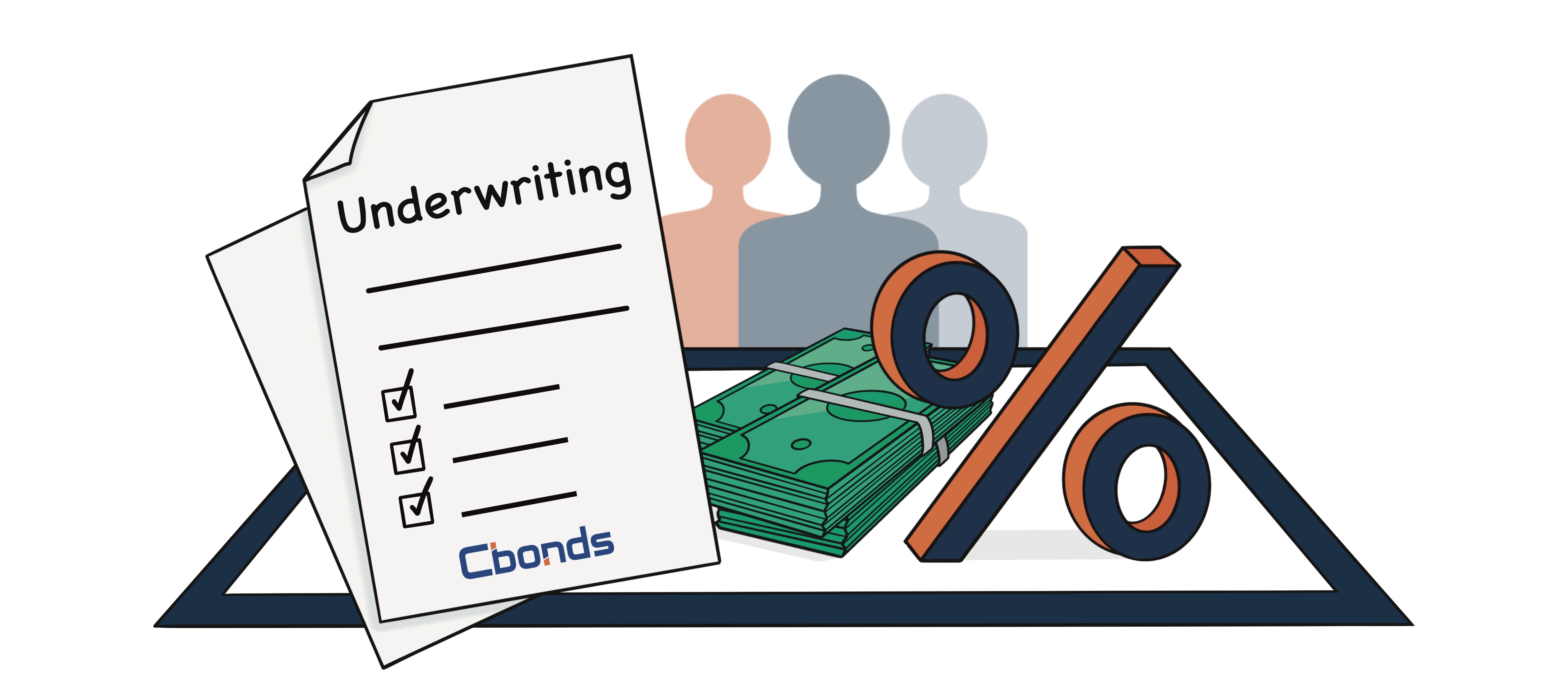By
Konstantin Vasilev Member of the Board of Directors of Cbonds, Ph.D. in Economics
Updated July 1, 2023
What Does Underwriting Mean?
Underwriting is an essential process wherein individuals or institutions assume financial risk in exchange for compensation. This practice predominantly applies to loans, insurance policies, and investments. The term "underwriter" emerged from the historical practice of signatories indicating their willingness to accept a specific premium by writing their names under the total risk amount.
While the methods and procedures have evolved over time, underwriting remains a pivotal function in the contemporary financial landscape. It involves a comprehensive evaluation of the associated risks and the determination of suitable terms and conditions for the involved parties. Through meticulous analysis and assessment, underwriters play a crucial role in managing risk and ensuring the sustainability of various financial transactions.

Types of Underwriting
Underwriting encompasses three primary categories: loans, insurance, and securities. Each of these branches involves a distinct set of underwriting practices to assess and manage the associated financial risks. Whether it’s evaluating the creditworthiness of borrowers, determining insurance coverage and premiums, or facilitating securities offerings, underwriting plays a vital role in ensuring sound financial decisions and mitigating potential risks.
Loan Underwriting
Underwriting is an integral part of the loan process, ensuring responsible lending practices across various types of loans. While automated underwriting systems are common, they primarily consider factors such as credit history, financial records, collateral value, and loan size. The duration of the automated underwriting process can vary from minutes to weeks, depending on the need for human intervention.
Among the different types of loan underwriting, mortgage underwriting often involves a human underwriter and is the most familiar to individuals. A mortgage underwriter carefully evaluates an applicant’s financial circumstances, including income, liabilities (debt), savings, credit history, and credit score. The turnaround time for mortgage underwriting is typically within a week.
Refinancing applications often have longer processing times due to prioritizing buyers with imminent deadlines. While loan applications can be approved, denied, or suspended, most receive conditional approval. This means the underwriter requires additional documentation or seeks clarification before finalizing the loan terms.
Insurance Underwriting
Insurance underwriting focuses on assessing the risks associated with potential policyholders, particularly those seeking health or life insurance coverage. In the past, health insurance underwriting involved evaluating an applicant’s health, including pre-existing conditions, to determine coverage availability and premium rates. However, since the implementation of the Affordable Care Act in 2014, insurers are no longer allowed to deny coverage or impose limitations based on pre-existing conditions.
Life insurance underwriting aims to evaluate the risk of insuring an individual based on various factors such as age, health, lifestyle, occupation, family medical history, and hobbies. Underwriters analyze these factors to determine coverage approval, along with coverage amounts, prices, exclusions, and conditions, or outright rejection.
The underwriting process is also crucial in mortgage lending. Mortgage underwriting involves a comprehensive assessment of an applicant’s financial situation, credit history, employment status, debt-to-income ratio, and other relevant factors. The underwriter evaluates the risk associated with lending money for a home loan and assesses the borrower’s ability to make mortgage payments. This process helps mortgage lenders make informed decisions regarding the approval and terms of the mortgage.
Securities Underwriting
Securities underwriting involves evaluating the risk and determining the appropriate pricing of securities, typically associated with an Initial Public Offering (IPO). This process is typically carried out by an investment bank acting on behalf of potential investors. Upon completing the underwriting process, the investment bank purchases the securities from the company conducting the IPO and subsequently sells them in the market.
Underwriting serves the dual purpose of ensuring that the company successfully raises the required capital through its IPO and providing the underwriters with a premium or profit for their services. Investors greatly benefit from the thorough vetting process performed during underwriting, as it enables them to make well-informed investment decisions.
Securities underwriting encompasses various types of securities, including individual stocks and debt securities, such as government, corporate, or municipal bonds. Underwriters or their respective institutions acquire these securities to resell them at a profit, either to investors or dealers who further distribute them. When multiple underwriters or groups collaborate, it is referred to as an underwriter syndicate.
How Long Does Underwriting Take?
The timeframe for underwriting varies across different investment products, as each requires a thorough assessment of its risk profile. Personal loans and insurance products are generally straightforward to underwrite.
Personal Loans
The duration of underwriting for personal loans can vary depending on several factors. Typically, the process takes anywhere from a few days to a couple of weeks. During underwriting, the lender assesses various aspects of the borrower’s financial profile, such as credit history, income, employment status, and debt-to-income ratio. They also review the loan application and supporting documentation. The time it takes for underwriting can be influenced by the complexity of the borrower’s financial situation, the responsiveness of the borrower in providing the required information, and the efficiency of the lender’s internal processes. It’s important to note that while some lenders may offer quick underwriting decisions, others may take longer, especially if they prioritize thorough evaluation and risk assessment.
When it comes to car loans, an algorithm is typically employed to compare the applicant’s profile with that of other borrowers. This process is usually completed within a few days, sometimes even instantaneously.
On the other hand, home mortgages take longer as the underwriter verifies the borrower’s income, employment details, and credit history, which can be time-consuming. Full approval for a home loan can take up to 45 days, although the underwriting process constitutes only a fraction of this timeframe.
Insurance
Underwriting insurance involves a similar process to loan underwriting, but insurers assess the probability and magnitude of potential claims concerning the expected premiums. Any property or auto insurance company takes into account factors such as the insured person’s age, geographic location, and past claims history.
Life insurance policies involve more complexity due to considering the insured’s medical history. Underwriting life insurance policies can take a month or longer, although many decisions are typically issued within a few days.
Stocks and Bond Issues
Securities represent the most intricate products to underwrite. When a company issues bonds or stocks, the underwriter, often an investment bank, scrutinizes the company’s financial records, cash flows, assets, and liabilities and identifies any discrepancies. This comprehensive process can span from six to nine months.
What Information Do Underwriters Consider?
Whether assessing mortgage applications or underwriting insurance policies, underwriters play a crucial role in the financial world. They carefully analyze various aspects of each applicant’s financial situation to determine how much risk is involved and make informed decisions accordingly. The underwriting process involves evaluating factors such as credit reports, loan applications, and financial information provided by the applicant.
In the mortgage underwriting process, a mortgage lender assesses the applicant’s credit history, income, and employment status to determine their eligibility for a loan. They also consider the down payment amount and evaluate the property’s value through a title search. Additionally, underwriters calculate the borrower’s debt-to-income ratio to assess how much debt they can comfortably manage. Closing costs and the borrower’s overall financial information are also considered before making an underwriting decision.
In the insurance underwriting process, insurance underwriters work for insurance companies to determine the appropriate coverage for applicants. They assess the level of risk associated with each applicant and evaluate factors such as their medical history, lifestyle habits, and potential for large or frequent claims. Insurance agents collaborate with underwriters to gather necessary information and guide applicants on selecting the right coverage and specified premium.
Investment banks also employ underwriters who evaluate investment risks for various financial instruments. Underwriters analyze companies issuing stocks or bonds’ financial statements, cash flow, and debts. They assess the issuer’s credit rating and the potential risks and returns associated with the investment. This helps investors make informed decisions and benefits them in understanding the level of risk involved.
How Does Underwriting Affect the Market Price?
The main function of an underwriter is to create a fair and stable market for financial transactions. This applies to various contexts, including insurance policies, loans, and investments. Every transaction carries a certain level of risk, such as the potential for default, claims, or failure, which can lead to losses for the involved parties. The underwriter’s role is to assess these risks, evaluate the applicant’s eligibility, and determine the appropriate terms and conditions.
Underwriters, particularly in insurance companies and financial institutions, thoroughly evaluate applicants to assess their risk profile. This assessment involves reviewing factors such as credit reports, loan applications, tax returns, and recent bank statements. By analyzing these documents, underwriters can gauge the applicant’s financial stability, debt levels, and repayment capacity. They also consider factors like property insurance and retirement savings to evaluate the overall financial well-being of the applicant.
Underwriting involves a comprehensive risk assessment, where underwriters weigh the potential risks against the desired coverage or investment. They calculate the risk associated with the transaction and determine the appropriate interest rate, monthly payments, or premiums. By assessing risk factors and applying the concept of calculated risk, underwriters aim to minimize the likelihood of missed payments, defaults, or claims.
Throughout the underwriting process, underwriters play a vital role in determining whether an application is approved or rejected. Their evaluation helps identify risk takers or applicants with excessive debt who may not be suitable for the desired coverage. Additionally, underwriters ensure that the underwriting decisions align with the insurance company’s or financial institution’s bottom line, contributing to the overall risk management strategy.
Ultimately, the underwriting process facilitates mortgage approvals, insurance coverage, and investment opportunities by balancing risk and reward. By assessing risk, underwriters protect the interests of both the applicants and the institution, creating a stable and fair marketplace for financial transactions.
Bond Screener
Watchlist
Excel Add-in
API





















